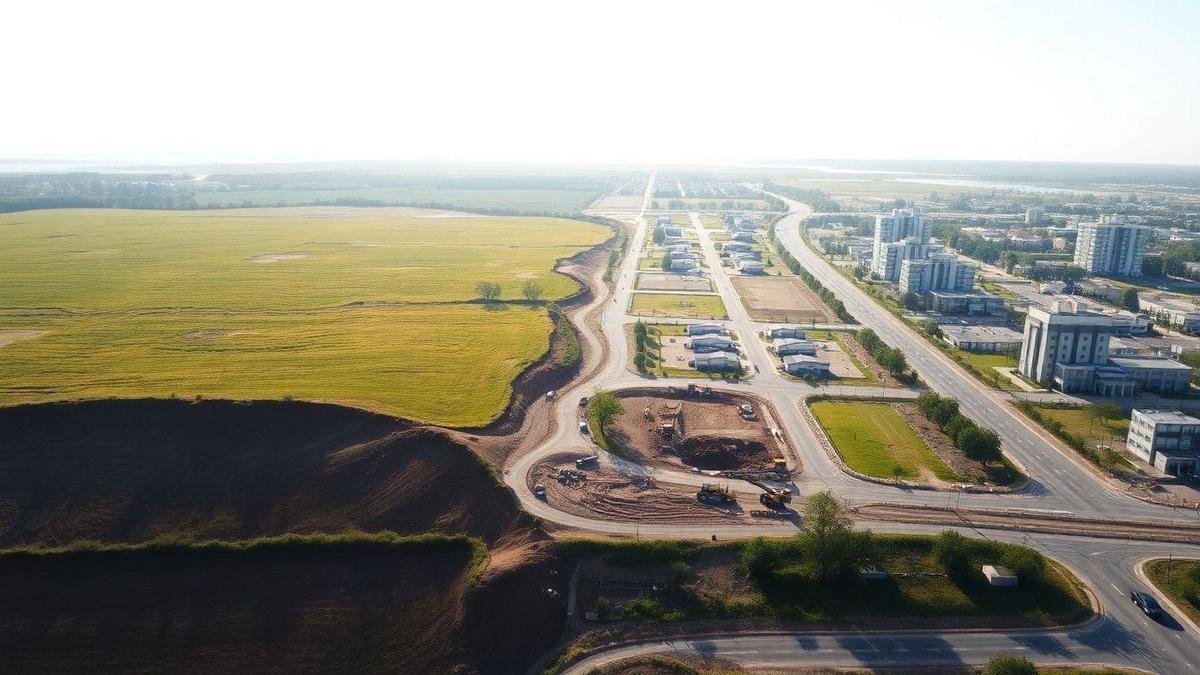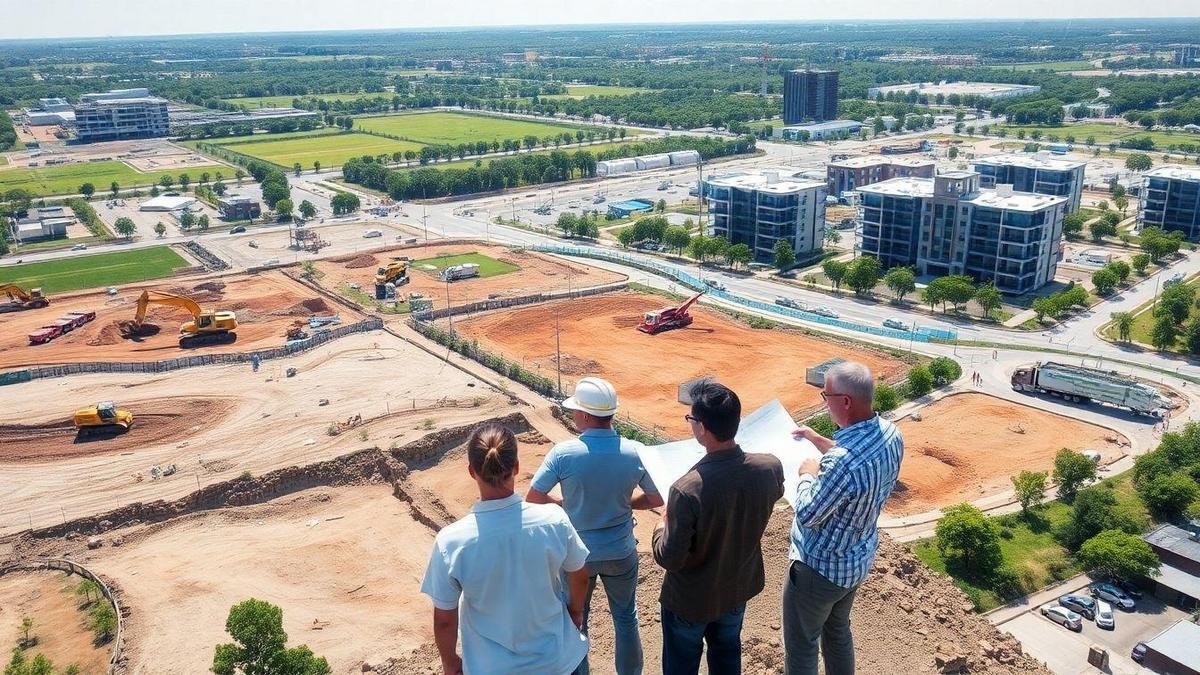The land development timeline is a crucial journey for investors seeking success in property development. It involves essential stages like zoning, permitting, and economic feasibility. Each phase holds significant importance, influencing investment returns and shaping the overall project. This article will explore the key elements and strategies that smart investors need to know. It will highlight the impact of sustainable practices and global trends to navigate this dynamic landscape effectively.
Key Points to Remember
- Land development takes time and planning.
- Research local rules and regulations.
- Understand the market demand for land.
- Budget for costs like permits and surveys.
- Work with experts for better decisions.

Understanding the Land Development Timeline
Key Stages in Property Development
The land development timeline consists of several key stages. Each stage plays a crucial role in transforming raw land into a profitable investment. Here are the main steps involved:
- Site Selection
Choosing the right location is vital. Investors need to consider factors such as zoning laws, accessibility, and market demand.
- Feasibility Study
This study assesses the viability of the project, including financial analysis, environmental impact evaluations, and market research. For a comprehensive understanding of conducting feasibility studies, refer to the land development feasibility study guide.
- Planning and Design
This phase involves creating detailed plans and designs for the property. Architects and planners work together to ensure that the project meets regulations and community needs.
- Permitting
Obtaining the necessary permits can be a lengthy process. Investors must navigate local regulations and secure approvals before moving forward. For insights on the permit process, check out this resource on land development permits.
- Construction
This is where the physical development takes place. Builders break ground and begin construction according to the approved plans.
- Marketing and Sales
Once the project is complete, it’s time to market the property. Effective marketing strategies are essential for attracting buyers or tenants. Explore marketing strategies for land to enhance your approach.
Importance of Each Phase in the Timeline
Understanding the importance of each phase helps investors make informed decisions. Each step contributes to the overall success of the project:
- Site Selection: A poor location can lead to low demand.
- Feasibility Study: This step uncovers potential risks and rewards, guiding financial decisions.
- Planning and Design: Well-thought-out designs attract buyers and meet community standards.
- Permitting: Delays in this phase can stall the entire project.
- Construction: Quality construction affects the longevity and appeal of the property.
- Marketing and Sales: Effective strategies can maximize profits.
How Each Stage Affects Investment Returns
Each stage in the land development timeline directly impacts investment returns. For instance, a thorough feasibility study can reveal whether a project is worth pursuing. If the study shows a solid return on investment, the project is more likely to succeed. For a deeper dive into ROI calculations, visit this guide on Return on Investment in land development.
Here’s a simple table illustrating how each phase can influence returns:
| Phase | Impact on Returns |
|---|---|
| Site Selection | Right location = higher demand |
| Feasibility Study | Identifies risks, guiding financial choices |
| Planning and Design | Attractive designs can boost property value |
| Permitting | Delays can increase costs |
| Construction | Quality work can enhance marketability |
| Marketing and Sales | Strong marketing leads to quicker sales |
By understanding these phases, investors can better navigate the complexities of land development.

The Role of Zoning and Permits
What Zoning Means for Investors
Zoning is a critical aspect of land development that dictates how a piece of land can be used. For investors, understanding zoning laws is essential. These laws determine whether a property can be used for residential, commercial, or industrial purposes. If an investor buys land with the wrong zoning, they may face significant hurdles in developing the property as intended. For a beginner’s guide, see Zoning in the US for Beginners.
For example, if an investor purchases land thinking it can be developed into a shopping center, but it is zoned for residential use, they will need to go through a lengthy process to change the zoning. This could lead to delays and additional costs.
Navigating the Permit Process
The permit process is often seen as a maze that can be tricky to navigate. Investors must obtain various permits before starting any development project. These permits can include building permits, environmental permits, and occupancy permits. Each type of permit has its own requirements and timelines.
To illustrate the importance of this process, consider the following table:
| Permit Type | Description | Typical Duration |
|---|---|---|
| Building Permit | Required for construction projects | 2-6 weeks |
| Environmental Permit | Ensures compliance with environmental laws | 1-3 months |
| Occupancy Permit | Allows for the use of the building | 1-4 weeks |
Understanding these permits and their timelines is crucial for investors. Delays in obtaining permits can push back the entire land development timeline.
Impact of Zoning on the Land Development Timeline
Zoning affects the land development timeline significantly. If zoning changes are required, this can extend the timeline by months or even years. Additionally, if an investor needs to secure multiple permits, the project may face further delays.
To avoid these pitfalls, investors should:
- Research local zoning laws before purchasing land.
- Engage with local planning departments to understand the permit requirements.
- Plan for potential delays caused by zoning changes or permit approvals.
By being proactive, investors can better manage their projects and keep the land development timeline on track.

Project Planning Phases Explained
Initial Planning and Its Importance
In the journey of land development, the initial planning phase serves as the cornerstone for success. This stage involves gathering essential information, identifying goals, and assessing potential challenges. A well-crafted plan lays the groundwork for the entire project. It helps investors visualize the end goal and strategize accordingly.
During this phase, it is crucial to engage with stakeholders, including local communities, government bodies, and potential investors. Their insights can shape the project and align it with local needs. For instance, a developer may discover that a community desires green spaces, which can be integrated into the project from the start.
Steps to Create a Successful Project Plan
Creating a successful project plan involves several key steps:
- Define Objectives: Clearly state what the project aims to achieve.
- Conduct Research: Gather data on the market, regulations, and environmental factors.
- Engage Stakeholders: Involve all parties early to gain support and insights.
- Develop a Timeline: Outline the phases of development and set deadlines.
- Allocate Resources: Determine the budget, tools, and personnel needed.
| Step | Description |
|---|---|
| Define Objectives | Set clear goals for the project. |
| Conduct Research | Analyze market and regulations. |
| Engage Stakeholders | Involve communities and investors for support. |
| Develop a Timeline | Create a schedule for development phases. |
| Allocate Resources | Plan budget and resources required for the project. |
How Planning Affects Overall Development Timeline
The planning phase significantly influences the land development timeline. A thorough plan minimizes delays and streamlines the process. For example, when a developer has a clear timeline, they can allocate resources efficiently and avoid bottlenecks.
Moreover, unexpected challenges can arise during development. Having a solid plan allows for quick adjustments, keeping the project on track. By anticipating potential issues, developers can save time and costs in the long run. In essence, the initial planning phase is not just a formality; it is a vital step that sets the tone for the entire project.

Economic Feasibility Analysis
What is Economic Feasibility?
Economic feasibility is the process of assessing whether a proposed land development project is financially viable. It involves evaluating the potential costs, revenues, and overall financial benefits. Investors look at factors like land prices, construction costs, and expected returns. A thorough economic feasibility analysis helps in making informed decisions, minimizing risks, and ensuring that the project aligns with financial goals. For more on this topic, refer to Cost Breakdown in US Land Development.
Tools for Conducting Feasibility Studies
Several tools assist in conducting feasibility studies. These tools help investors analyze various aspects of a project:
| Tool | Description |
|---|---|
| Cost-Benefit Analysis | Compares the costs of a project to its expected benefits. |
| Market Research | Gathers data on demand, competition, and pricing. |
| Financial Modeling | Projects future revenues and expenses based on assumptions. |
| SWOT Analysis | Identifies strengths, weaknesses, opportunities, and threats. |
These tools provide a structured approach to evaluating the economic viability of land development projects.
Importance of Feasibility in the Development Timeline
Feasibility studies play a crucial role in the land development timeline. They help investors identify potential challenges early on. By conducting these studies, investors can:
- Save Time and Money: Early identification of issues can prevent costly mistakes.
- Make Informed Decisions: Understanding the financial landscape allows for better planning.
- Attract Investors: A solid feasibility study can draw in additional funding.
In short, feasibility studies are the backbone of any successful land development project. They guide investors through the complexities of the process, ensuring that every step is grounded in solid financial reasoning.

Risk Assessment in Land Development
Identifying Potential Risks
In land development, recognizing potential risks is crucial. Various factors can impact a project, such as:
- Market fluctuations: Changes in demand can alter property values.
- Regulatory changes: New laws may affect zoning and permits.
- Environmental concerns: Issues like contamination can lead to costly delays.
- Financial instability: Unexpected costs can strain budgets.
These risks can derail even the best-laid plans. By identifying them early, developers can prepare for challenges that may arise.
Strategies to Mitigate Risks
To navigate the uncertainties of land development, several strategies can help minimize risks:
- Conduct thorough research: Understand the market, regulations, and environmental conditions.
- Engage experts: Hiring professionals like environmental scientists or legal advisors can provide valuable insights.
- Create a contingency plan: This plan should outline steps to take if risks materialize.
- Implement insurance options: Coverage can protect against financial loss.
By employing these strategies, developers can protect their investments and enhance project success.
How Risk Assessment Influences the Timeline
Risk assessment plays a pivotal role in determining the land development timeline. Early identification of risks allows for:
- Better planning: Developers can allocate time for potential issues.
- Faster decision-making: With risks understood, teams can act quickly.
- Reduced delays: Addressing risks upfront can prevent setbacks.
Ultimately, a well-executed risk assessment can streamline the development process, keeping projects on track.

Sustainable Land Use Planning
Benefits of Sustainable Practices
Sustainable practices in land development have numerous advantages. They not only protect the environment but also boost the economy. Here are some key benefits:
- Reduced Environmental Impact: Sustainable practices help preserve natural resources and biodiversity.
- Cost Savings: Efficient use of resources can lower long-term costs for developers and investors.
- Enhanced Community Well-being: Sustainable developments often improve the quality of life for residents by providing better access to green spaces and clean air.
Integrating Sustainability into Development
To integrate sustainability into land development, developers can adopt several strategies. These strategies promote responsible use of land and resources:
- Smart Zoning: This involves planning areas for specific uses, such as residential, commercial, or agricultural, to minimize conflict and enhance efficiency.
- Green Infrastructure: Incorporating parks, green roofs, and permeable surfaces can manage stormwater and reduce urban heat.
- Energy Efficiency: Utilizing renewable energy sources and energy-efficient building materials reduces reliance on fossil fuels.
How Sustainability Affects the Land Development Timeline
Sustainability can influence the land development timeline. Here’s how:
| Factor | Impact on Timeline |
|---|---|
| Regulatory Approvals | Sustainable projects may require additional reviews, extending timelines. |
| Design Phase | Incorporating sustainable practices may lengthen the design phase due to the need for specialized knowledge. |
| Construction Process | Using eco-friendly materials can lead to delays if supplies are limited. |
Investors should keep these factors in mind as they plan their projects. Adopting sustainable practices may take longer initially but can lead to greater long-term benefits.

Investment Returns Timeline
Understanding Return on Investment (ROI)
Return on Investment, or ROI, is a critical measure for investors. It helps gauge how much profit is made on an investment compared to its cost. To calculate ROI, the formula is simple:
[
text{ROI} = frac{text{Net Profit}}{text{Cost of Investment}} times 100
]
For instance, if an investor spends $100,000 on a land development project and earns $150,000 upon selling it, the ROI would be:
[
text{ROI} = frac{150,000 – 100,000}{100,000} times 100 = 50%
]
This means the investor made a 50% profit on their investment. Understanding this metric is essential for making informed decisions in land development.
Factors That Influence Investment Returns
Several factors play a role in determining investment returns in land development. Here are some key elements to consider:
- Location: The value of land varies significantly based on its location. Prime areas tend to yield higher returns.
- Market Trends: Economic conditions and market demand impact property values. Staying updated on trends can help investors make better choices.
- Zoning Regulations: Local laws can affect how land can be developed. Knowing these regulations is crucial for success.
- Development Costs: Expenses related to construction, permits, and labor can eat into profits. Keeping these costs low is vital.
The Connection Between Timeline and ROI
The land development timeline is intertwined with ROI. A longer timeline can mean higher returns, but it also comes with risks. Here’s how they connect:
| Timeline Stage | Potential ROI Impact |
|---|---|
| Short-term (1-2 years) | Quick returns, but less potential growth |
| Medium-term (3-5 years) | Balanced risk and reward |
| Long-term (5 years) | Higher potential returns, but requires patience |
Investors must weigh the benefits of quick profits against the potential for greater returns over time. For instance, a developer who holds onto a property for several years may see its value appreciate significantly, leading to a more substantial ROI.

Smart Investors and Their Strategies
Characteristics of Smart Investors
Smart investors share several key traits that help them thrive in land development. They are often:
- Analytical: They examine data and trends carefully to make informed choices.
- Patient: They understand that good investments take time to mature.
- Adaptable: They can adjust to changing market conditions and seize opportunities.
- Networked: They build strong relationships with other professionals in the industry.
These characteristics allow them to navigate the complexities of land development effectively.
How to Make Informed Decisions
Making informed decisions is crucial for success in land development. Smart investors rely on various strategies to gather information. Here are some effective approaches:
- Research: They study market trends, zoning laws, and local economies.
- Consult Experts: They seek advice from real estate agents, urban planners, and financial advisors.
- Analyze Risks: They assess potential risks and rewards before committing to a project.
By employing these strategies, investors can make choices that align with their goals and the current market landscape.
Strategies for Navigating the Land Development Timeline
Navigating the land development timeline can be tricky. However, smart investors can follow these strategies to keep projects on track:
| Strategy | Description |
|---|---|
| Set Clear Goals | Define what success looks like for each project. |
| Create a Timeline | Develop a realistic schedule for each phase of development. |
| Monitor Progress | Regularly check on the status of the project and adjust as needed. |
| Stay Informed | Keep up with changes in regulations and market conditions. |
By implementing these strategies, investors can enhance their chances of success and reduce potential setbacks during the land development timeline.

Global Trends in Land Development
Emerging Markets for Investment
Investors are increasingly turning their attention to emerging markets. These regions often offer higher returns due to their rapid growth and development. Countries in Africa, Southeast Asia, and Latin America are showing great promise.
For instance, in Africa, nations like Kenya and Nigeria are witnessing urbanization at an unprecedented pace. This surge leads to a demand for residential and commercial properties. In Southeast Asia, countries like Vietnam and Indonesia are also on the rise, attracting foreign investment due to their favorable economic conditions.
Key Factors Driving Investment:
- Population Growth: More people mean more housing and infrastructure needs.
- Economic Development: As economies grow, so do opportunities for land development.
- Government Policies: Supportive regulations can make investing easier.
Innovations in Land Development Practices
Innovative practices are transforming how land is developed. Technology plays a crucial role in this shift. For more on this, see Land Development Trends for 2025.
Examples of Innovations:
- Sustainable Building Materials: Using eco-friendly materials reduces environmental impact.
- Smart City Technologies: Integrating technology into urban planning improves efficiency and livability.
- Modular Construction: This method allows for quicker and more cost-effective building processes.
These advancements not only enhance the quality of developments but also attract investors looking for sustainable options.
How Global Trends Impact the Development Timeline
Understanding global trends is vital for anyone involved in land development. These trends can significantly impact the land development timeline.
Factors Influencing Timelines:
| Factor | Impact on Timeline |
|---|---|
| Economic Stability | A stable economy speeds up approvals. |
| Regulatory Changes | New laws can delay projects. |
| Technological Advances | Faster methods can shorten development time. |
For example, in regions where technology is embraced, projects often move faster. Investors who stay informed about these changes can better navigate the complexities of the land development timeline.
Conclusion
In summary, the land development timeline is a multifaceted journey that requires careful navigation through various stages, including zoning, permitting, and economic feasibility. Each phase plays a pivotal role in determining the project’s success and ultimately influences investment returns. Investors must remain vigilant and informed, understanding the impact of local regulations, market demand, and sustainable practices. By employing strategic planning, conducting thorough feasibility studies, and assessing risks, they can enhance their chances of success while minimizing potential setbacks.
As the landscape of land development continues to evolve with emerging markets and innovative practices, staying informed about global trends will be crucial. With the right knowledge and strategies, investors can turn challenges into opportunities, ensuring a profitable venture in the dynamic world of property development.
For more insights and guidance on land development, explore additional articles at Land Development Hub.

No responses yet